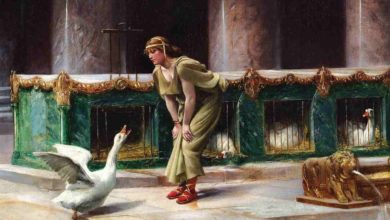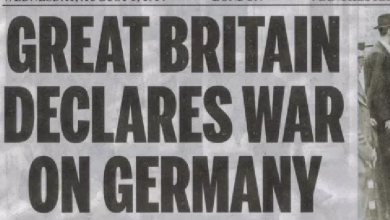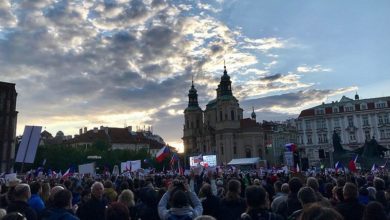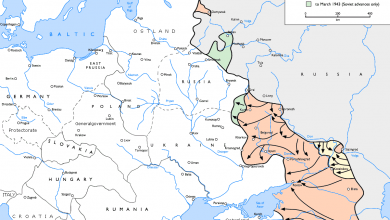Who Is European? A History of Peoples and Movement

The MC?E definition of Europe includes all members of the Council of Europe. Some like Georgia and Azerbaijan are located in Asia but maintain culturally European populations. This would be a good place to start in our quest for the “European”. But let us go back to the beginnings.
The Beginnings: prehistoric populations
Homo Sapiens is thought to have emerged on the continent of Africa and migrated outward from there. The greatest gene variety is found among African populations. As the number of genetic mutations grows with time, this would place the oldest human population in Africa. Mutations like blue eyes – thought to have originated in the Baltics because of its greater frequency there – blond hair or light skin, emerged later among more isolated populations. These have not been isolated long enough, nor experienced enough different mutations, to constitute distinct races or species. Most of the human genome is found on the African continent in native populations. Indeed the mutation for white skin is found on an island populated by African migrants in the Indian Ocean even as it is widespread elsewhere. The original populations of Europe were thought to have dark skin, and frequently blue eyes.

Humanoids of various types were found outside of Africa – notably the Neanderthals in Europe and on the Asian steppes, and the Denisovans, largely in Asia. Little is known of their origins but Neanderthals met and interbred with Homo Sapiens. Today’s European genome has on average about 4% Neanderthal genes.
About 20,000 BCE, during the period of the “last glacial maximum”, much of Europe was covered with ice and uninhabitable. A warming period ensued which continues to this day, and small groups of people began to populate Europe in greater and greater numbers: Homo-Sapiens from the Middle East, and Neanderthal. This warming trend was interrupted by the “Younger Dryas” a period of cooling and re-glaciation in Europe around 12,000 BCE. Three “foyers” of habitation remained during the Younger Dryas: an area around what is now the Basque country, southern Italy, and South Western Russia. The population was forced to exit the rest of the continent by the ice and cold. After warming trends resumed about 10,000 BCE Europe was repopulated from these three areas as well as from the Middle East.
The end of the Mesolithic period, about 6,000 BCE, finds an indigenous hunter gatherer population in Europe. The development of agriculture in the Middle East created pressure on the land. This led to an exodus of hunter gathers from this region and later of farming populations themselves, looking for better land, into Europe. Indigenous Neanderthal had already become extinct after some inter-breeding with Homo Sapiens.
More prehistoric mingling
Resulting from these early migrations a European population with a high frequency of Semitic and Turkic genes from the Middle East is then found throughout Europe, except in the Baltics and northern regions where populations from the Russian “foyer” dominated. The situation continues with gradual modification by immigrants into Europe from the Russian steppes until the beginning of the Bronze age from 4,000 to 5,000 BCE. These new Indo-Aryan immigrants are part of the Indo-European language group, which also went Eastward and South from their original home on the Russian steppes into Northern India (Sanskrit) and Persia (Iran). The Germanic and later Slavic branches of the Indo-Aryans resettle the continent and either suppress or intermingle with the old-European populations.

Only in Southern Italy and Spain do the old European populations of Semitic and Turkic descent remain dominant, but this is to be reversed later in Spain with invasion by the Visigoths and in Italy, but only partially so, by the Lombards – both Germanic tribes. Italy was also the recipient of a Semitic Jewish immigration during the Jewish diaspora of the Roman period and remains to this day, especially in the South, somewhat distinct genetically.
The Indo-European influx leads to the Etruscan, Minoan and Mycenaean cultures, followed on by the Trojan, Greek and Roman civilizations in Europe and Asia minor.

A caveat is necessary here. Research on pre-historic populations, based initially on archeological finds and linguistics, has been recently supported by genetics. Though scientific in every sense this research remains somewhat speculative until much more evidence is available.
From here on out, our still relatively simple heritage becomes inexorably mixed with that of all surrounding regions and half the world. Ancient Egypt had close relationships with both Greek and Roman civilizations and those of the Middle East and Sub-Saharan Africa. Unknown populations called the Sea People invaded the Eastern Mediterranean during what is known as the “collapse of bronze age civilizations” and dominated for a time.

Wars, empires and plagues
After the historic civilizations of the region were rebuilt in the iron age, Carthaginians from North Africa, probably themselves Phoenicians, invaded Europe through France, Switzerland and over the Alps into Italy. Defeated by the Romans, they settled into southern Italy for decades before eventually being driven out.
On the borders of the Eastern Empire different people vied with Roman armies for dominance. Parthes (Indo-Iranians), Amazons, Saracens and eventually a Mongolian steppe tribe, the infamous Huns, all intermarried and took mates by force in the territories they conquered, leading to population mixtures difficult to quantify before modern genetics.
In addition to armies and invasions one can not underestimate the role of trade, cultural exchange and immigration in bringing populations together and modifying the European gene pool. A recent study of DNA extracted from remains of ancient Romans by Stanford University and Italian researchers found a remarkably high percentage of non-indigenous genetic material, leading researchers to conclude that the city was even more cosmopolitan than originally thought. But this was probably true of many of the cities of the Empire where most people lived.
Our readers will be somewhat more familiar with the admixture of European populations through trade, immigration, colonization and, of course, war in the period after the fall of the Roman Empire. Population bottlenecks leading to narrowing of the genetic pool like that of the Bubonic plague, or the destructive Thirty Years’ War may be less known for their demographic effects. Some of the more notable foreign influxes in the post Roman period include the Muslim invasions of the 8th century, stopped by the Francs at Tours but remaining in control of Spain for more than half a millennium. The Moors brought an important Jewish migration from the Middle East in their wake.
The Mongols from across the great Asian steppes, eight time zones away, reached the Soja river in Hungary before turning back in 1241. The Turks in their turn reached the gates of Vienna before being turned back in 1683 and continued for centuries in the Balkans.
European ethnic groups themselves were inextricably mixed during the several millennia of the European project. The Vikings became Norseman and then Normans, invaded England, decimating the Anglo-Saxon nobility and changing the language from an exclusively Germanic tongue to one heavily influenced by Latin and French. Returning to whence they had recently come, they then fought the hundred years war in Western France, bringing a good bit of the now Anglo-Norman culture with them. Recent findings indicate an extensive Viking demographic presence, and not simply one of coastal marauders, in the previously largely Celtic gene pool of Ireland. Viking or Norman conquest went as far as Sicily where it is estimated that as much as 10 t0 20 percent of the population now has blond hair or blue eyes. Sicily was itself also subject to and heavily influenced by Arab conquests as were parts of the Italian peninsula and earlier by Phoenicians, Greeks and Romans.
Examples of the movements of European folk groups are too numerous to count: Slavs and Turks moved into the Balkans, Hungarians settled in Northwest Romania, Albanians in Italy, Greeks along the Italian coast. With these movements, cultural and physical intermingling always followed. The great European cities have always been international centers.

European colonizations around the world also resulted in considerable inter-mingling of populations with many former colonists and their offspring returning to Europe. Amerindian and French allies fought together against the British in North America. Black creole, originally from Africa, became products of French civilization, yielding in turn Europeans like Alexander Dumas (The Three Musketeers), Aimé Césaire (Discourse on Colonialism) and Leopold Senghor (French Academician) among their progeny. Some of these ex-colonies are now part of France.
Citizenship and Ethnicity
Surely even if European genetics is so diverse, citizenship or ethnic identity can define who is a European? Legally this is perhaps correct, at least as far as citizenship is concerned, and making exceptions for dual citizenship, but over time even this concept of “European” has proven elusive. The Romans originally granted citizenship to only propertied males of Rome. This was soon expanded as the empire grew. Rome granted citizenship to many conquered cities and provinces, many in Africa and Asia, but often only partial citizenship with much curtailed rights. For a time during the dark ages the idea of legal citizenship was replaced by feudal property laws and fealty to be supplanted later after the Renaissance by the ability of duchies and patented localities to determine who were their own citizens.
Later, nation states applied notions like ius soli and ius sanguinis to try to define and control their subjects. Today Ireland, Italy, Poland, Spain and Hungary offer citizenship under widely differing rules to individuals descending from a national forbearer (ius sanguini), even when they have never set foot in the country or speak a word of the language. Rules often do not require more than one grandparent to have been born or descended from someone born in the country.
France, Greece, Portugal, Spain and Germany (after 2000) offer limited ius soli under certain conditions, usually that in addition to the child one of the parents was born there, or the child waits until a certain age. The rules are as complicated as there are countries and have changed often.
Ethnicity is not much help either. Certainly speaking a European language or dialect is a clear marker of ethnicity, though non Indo-European languages like Finnish, Hungarian Estonian and Sami, all Finno-Ugric, and Euskara (Basque) are spoken within Europe. The Basque language Euskara may be the only language still spoken to have originated on the European continent prior to the introduction of Indo-European languages. These originated on the Russian steppe in Asia and are also spoken in India and Iran. Foreigners can also master both European language and dialects.
Not even common experience is all that helpful. An Albanian’s experience of the last century is totally different from an Englishman’s or Pole’s. Nor are European food and other ethnic traditions determinate. It would be hard to define a common European aspect to food and families retain these customs to differing degrees.
Is there a core set of European values? Not all Europeans would espouse any one set or even sub-set of values. Even Christian values disputed between Protestant and Catholic are honored more often in the breech.
Globalization is hardly new, the human race one large family. Genes, values, languages, music, dance and food all travel liberally. “European” is a project of human beings who call themselves Europeans and participate in what we call Europe. Other definitions do not stand scrutiny.





